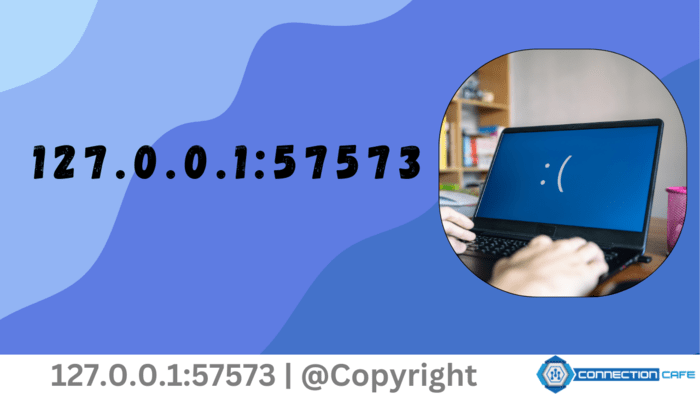When working with network applications or server-client architectures, you may encounter the IP address “127.0.0.1” paired with a port like “57573.” This combination typically represents a connection attempt to a localhost server—essentially, a server running on your own machine. However, it’s common to encounter connection errors when trying to connect to this address and port. Understanding why these errors occur and how to resolve them is essential for developers, system administrators, and even tech enthusiasts. This article will walk you through troubleshooting techniques and solutions to address these connection issues effectively.
Understanding 127.0.0.1:57573
Before diving into troubleshooting, it’s crucial to understand the role of “127.0.0.1” and “57573.” The IP address 127.0.0.1 is commonly known as “localhost” and is reserved for loopback connections. This means any application using this IP is connecting back to the same device it’s being run on. It is useful for testing applications, servers, and databases without exposing them to external traffic. Port 57573, in this context, is an arbitrary port number chosen by the application to listen for incoming connections. Different applications use various port numbers, and if you’re facing an issue with this port specifically, it’s likely the application’s default configuration or a temporary assignment.
Connection issues involving 127.0.0.1:57573 can occur for a number of reasons, from firewall settings to configuration errors. Let’s go over some of the most common causes and practical ways to resolve them.
Common Causes of Connection Errors at 127.0.0.1:57573
Application Not Running on Specified
Port One of the most common reasons for a connection error is that the application isn’t actually running on port 57573. In some cases, the application may fail to start, or it may default to another port without notifying the user. This can lead to a situation where attempts to connect to 127.0.0.1:57573 result in an error.
Firewall or Security Software Interference
Security software and firewalls are designed to prevent unauthorized connections, which can sometimes lead to blocking legitimate ones, including localhost connections. Some firewalls or security suites might mistakenly flag applications attempting to use specific ports like 57573, blocking them without clear notifications.
Incorrect Network Configuration
Misconfigurations in network settings, such as proxy settings or the hosts file, can result in failed connections. If localhost or the IP address 127.0.0.1 is misconfigured, connections to the specified port might fail or be rerouted incorrectly.
Port Conflicts
Another common reason for connection issues is a port conflict. If another application is already using port 57573, then your desired application won’t be able to bind to it, resulting in an error.
Loopback Restrictions on Certain Systems
Some operating systems impose restrictions on loopback addresses, especially with virtualized environments or network sandboxes. This can prevent applications from successfully binding to or listening on 127.0.0.1:57573.
Troubleshooting Steps to Resolve 127.0.0.1:57573 Connection Errors
Step 1: Verify the Application Status and Port
The first step in troubleshooting is to check if the application is actually running and listening on port 57573. You can do this by using command-line tools:
1- On Windows: Use `netstat -an | find “57573”` to see if any process is listening on this port.
2- On Linux/Mac: Use `lsof -i :57573` to check if the port is being used.
If you don’t see any application listening on port 57573, it’s likely that the application either failed to start or is using a different port.
Step 2: Check the Application Logs for Errors
Application logs can provide crucial information about startup issues, binding failures, or configuration errors. Look for log files typically located within the application’s installation directory or accessible through a console output. Logs can often point you directly to the root cause of the problem, such as missing permissions or configuration mismatches.
Step 3: Verify Firewall and Security Software Settings
Firewall settings can block localhost connections, so it’s important to make sure 127.0.0.1:57573 is not restricted. Here’s how you can check:
1- Windows Firewall: Go to Control Panel > System and Security > Windows Firewall > Advanced settings. Check the inbound and outbound rules to ensure that the application is allowed to use port 57573.
2- Security Software: Many security applications have their own firewalls or connection monitoring. Check for any blocked applications or ports within these settings.
If you find the port or application is blocked, create a rule to allow the connection on port 57573 for localhost traffic.
Step 4: Check for Port Conflicts
To identify whether another application is using port 57573, you can use the same netstat or lsof commands from earlier. If a different process is using the port, you have two options:
1. Reconfigure your application to use a different, available port.
2. Terminate the process using port 57573 if it’s unnecessary or can be moved to another port.
Step 5: Test Network Configuration and Hosts File
The hosts file on your system is responsible for mapping hostnames to IP addresses. In some cases, entries in this file might interfere with localhost connections. Open the hosts file on your system (typically located at `/etc/hosts` on Linux/Mac or `C:\Windows\System32\drivers\etc\hosts` on Windows), and verify that there’s a line like this:
“`
127.0.0.1 localhost
“`
If this line is missing or has been altered, restore it to ensure proper routing of 127.0.0.1 requests.
Step 6: Restart the Application and Network Stack
Sometimes a simple restart of the application or network stack can clear up lingering connection issues. You can restart your application and, if necessary, restart your computer’s networking services:
1- On Windows: Use `net stop` and `net start` commands for specific services, or reboot the system.
2- On Linux/Mac: Use `sudo systemctl restart network` (for Linux) or simply restart the network interfaces.
Restarting the application itself might resolve temporary conflicts or binding issues on port 57573.
Step 7: Consider System or OS-Level Restrictions
Certain environments, like virtual machines or sandboxed applications, might impose restrictions on loopback connections for security. In such cases, consult your operating system documentation or virtualization settings to verify if loopback connections to 127.0.0.1:57573 are allowed. You may need to reconfigure permissions or modify the security settings of the virtual machine.
Preventing Future Issues with 127.0.0.1:57573 Connections
To avoid similar connection errors in the future, consider the following best practices:
1. Document Application Ports: Maintain a list of ports used by your applications. This will help you identify and troubleshoot conflicts or errors faster.
2. Regularly Update Applications and OS: Ensure your applications and operating system are up-to-date. Updates often include bug fixes and improvements that can resolve connectivity issues.
3. Set Firewall and Security Exceptions: For trusted applications, create firewall exceptions for localhost traffic, especially if they frequently use specific ports.
4. Monitor Application Logs: Regularly review application logs for any error patterns or unusual activity. Catching issues early can prevent major disruptions.
5. Automate Network Configuration Checks: Use scripts or monitoring tools to periodically check for port conflicts, configuration changes, and firewall rule updates.
Conclusion
Troubleshooting connection errors on 127.0.0.1:57573 requires a methodical approach to isolate potential issues, from verifying application status to examining firewall and network configurations. By following the steps outlined here, you can systematically identify and resolve most connection issues related to localhost traffic. Addressing these errors effectively not only helps in maintaining a stable development environment but also improves your overall understanding of network operations on your local machine.










